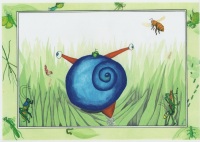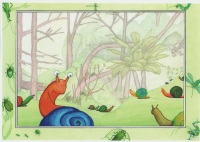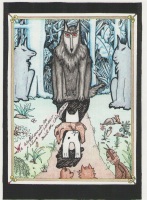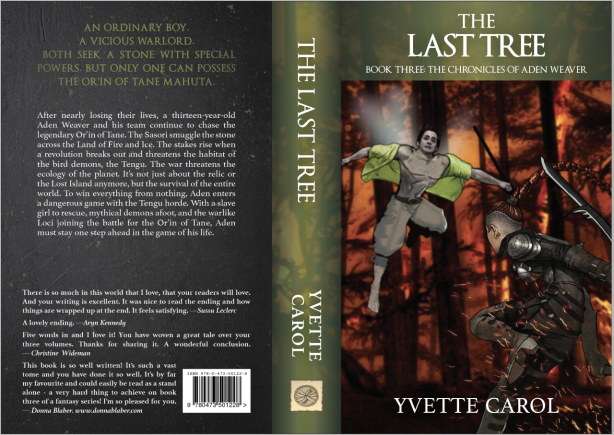Anthropomorphism gets a bad rap. When I started submitting my stories to publishers, as a seventeen-year-old in the eighties, I was told there were no publishers accepting anthropomorphic stories at that time, the publishers said no one was interested in reading stories about ‘talking animals or animals dressed as humans’.
In fact, our fascination with fantasies about talking animals predate the usually given source, of the deformed Phrygian slave, Aesop, in c.620- 560 BC. These tales have been found on Eyptian papyri dating 1000 years earlier and probably have their origins in prehistory. In particular, the writers of medieval times had a penchant for using animals as “spokespeople”. In the 1800’s, American writer, Joel Chandler, re-popularized the animal stories, in his fascinating tales of Brer Fox and Brer Rabbit.
When is a character anthropomorphic? As my friend, Joe Bunting, said over on The Write Practice: “Anthropomorphism is when an animal or object is given human traits. These can range from the oft-cited “whispering wind” to the talking toys in the Toy Story trilogy. Classical mythology and folktales utilize anthropomorphism frequently.”
What stories do you remember the most from your childhood? If you’re a writer or a creative person, you’ll love that question. It was award-winning New Zealand author, Kate de Goldi, who asked us this juicy question in one of her writing workshops of 2005.
I replied, ‘One of the first series that really gripped me as an early reader was the Moomintroll series by Tove Jansson.’ On Jansson’s website, it quotes Tove as saying the war had depressed her and she ‘wanted to write something naive and innocent’. She achieved that feat, quite remarkably in the Moomin series. As a young, impressionable reader, these sweet, funny books with their anthropomorphic characters made a big impression; I connected with Moomintroll and his friends in a big way.
When has anthropomorphism ever gone out of fashion?
“Alice in Wonderland was published in 1865, and afterward a flood of anthropomorphic creatures followed. There was Pinnochio in 1883, the walking, talking puppet. Then, in 1894, Kipling wrote The Jungle Book, including a story about an orphan boy who is befriended by a light-hearted bear named Baloo, a protective black panther named Bagheera, and is nearly killed by a malicious tiger called Shere Kahn.”
Joe Bunting, the Write Practice
In recent times, there has been renewed interest in anthropomorphism with the release of hit movies with book tie-ins like, Finding Nemo, The Lion King, Cars, Planes, Madagascar, The Little Mermaid, Shrek, Monsters Inc which have all been blockbusters and bestselling books, proving that the anthropomorphic story is still very much a “live” sub-genre of fantasy.
To my mind, there has always been a demonstrable market for this sort of animal fantasy adventure, yet there continues to be some stigma around the genre.
“It’s odd that unashamed fantasy still trails clouds of disapproval,” Terry Pratchett once said and I’ve often wondered the same thing. The sub-genre of anthropomorphism seems to further divide people. One man’s meat is another man’s poison so they say. When I showed the original version of ‘The Or’in of Tane Mahuta’ to an assessor, she said, “The story’s great, but lose the insects!” which reminded me of the quote, “Rulers are suspicious of new worlds where their writ does not run.”
I took heart however from my tutor and all-round heroine, Kate de Goldi’s words, when I shared with her my interest in animal fantasy. She said, “Don’t think about getting published. Write whatever your compulsion in your soul is to write. If you want to write about insects, there must be a reason for that.”
She reminded me yet again, that it is to ourselves as writers that we must be true. Even if that means going against the prevailing conventions. Creating anthropomorphic fiction may hit the big time or it may crash and fail, but if that’s where the muse calls then so be it. What about you, have you ever tried writing these characters? Which of the famous anthropomorphic characters do you like? I admire Kung Fu Panda, how genius is a panda who is also a martial arts expert? What is there not to love?
±
See ya’ in the funny papers,
Yvette K. Carol
@YvetteCarol1
±
Michael Moorcock, in reference to Watership Down: “if the bulk of American SF could be said to be written by robots, about robots, for robots, then the bulk of English fantasy seems to be written by rabbits, about rabbits, for rabbits.”






















I remember the advice to not write anything anthropomorphic when I started learning how to write children’s lit back in the early 1990s, but yeah, there is certainly a shift back to accepting it now, which is good. I think that, for me, anything goes as long as one doesn’t make the stories saccharine and didactic. 🙂
LikeLiked by 1 person
Yes. It was much more of a no-no twenty or thirty years ago than it is now, I agree. There’s so much more I could say on this subject of animal fantasy – for me, personally, I find it easier to lose myself in non-human characters, but that may just be a personal quirk. Thanks for commenting, Teresa!
LikeLiked by 1 person
I do like animal fantasies, too! My son was totally crazy about The Wind In The Willows and the Redwall series. 🙂
LikeLiked by 1 person
Yay! I’m a big fan of Brian Jacques’ Redwall series too so I’m with your son on that one. In fact, I’ve already partly prepared another post on this subject which features Jacques because he’s been such a big influence. That man could tell a story! He was a natural, and I was most disappointed not to read the whole series because the local library only had access to certain of the volumes (there were a great number, don’t quote me, but I think there were a dozen or so books). Did you read Watership Down, as a youngster? That was another powerful fictional experience for me, growing up! 🙂
LikeLiked by 1 person
No, I never read Watership Down, but it’s one of those classics that I want to read one day. Can’t wait to read your post on Jacques!
LikeLiked by 1 person
I loved reading about the history of anthropomorphism. I agree with you that it most likely predates history, as all native tribes I’ve heard of have stories featuring talking animals.
LikeLiked by 1 person
Yes, I feel the animal fantasy story has deep roots. Just think, Nicholas, of the mythological traditions of all ancient people’s and the similarities between the archetypes, the mischievous raven, the cunning fox, the industrious spider. These are the stories that fascinate me most! Thank you so much for the re-tweet and the comment 🙂
LikeLiked by 1 person
True! Not to mention totem animals, or gods with animal features (ancient Egyptian gods come to mind).
LikeLiked by 1 person
Yes, is there any more terrifying-looking adversary than Anubis? Or the crocodile-headed god? In ancient times, the rocks, and natural features were all believed to be imbued with supernatural life so what could be more natural than to make up stories? 🙂
LikeLike
Thank goodness you kept the ants. I love animals as humans.
LikeLiked by 1 person
Yay! Spoken like a true poet, Catherine. 🙂
LikeLike
Everyone needs to write the story that moves them most and fill it with passion. 🙂
How long has the man on the moon lived up there anyway?
Anna from Elements of Writing
LikeLiked by 1 person
Ha ha, good question, Anna! Love it. Yes, I agree wholeheartedly. As my dear friend, PJ Reece says, “Now let’s write our brains out passionately and with minimal reference to grids and rules. Let’s write from a love of the art and the heart of fiction.”
LikeLiked by 1 person
And not to forget the litany of Indian gods and goddesses, Haruman the monkey god, and Ganesh the elephant god in particular come to mind. And what a pity that our 21st century “civilisation” is losing touch with the “humanity” of animals, to the point that if we carry on like this whole species will be dying out before our eyes. I would say that now more than ever we need to give a voice to animals!!
LikeLiked by 1 person
Fantastic input, John, thank you! Yes, how could I forget the Indian pantheon, good point. The Chinese have a stunning array of animalistic mythical figures too. Being a big fan of mythology, I love to weave mythology into my fiction, which basically allows for ‘anything goes’. How can one write mythological-based fiction for kids without speaking animals? Gah! I really like that point about giving them a voice especially in these times. Yes. Exactly. 🙂
LikeLike
p.s. I was watching The History Channel today, a show I love, Ancient Discoveries, and with great synchronicity they mentioned that the crocodile-headed god of Egypt was called Sobek. There were many temples built to him, in which live crocs roamed! They said, “In ancient times, animals were thought to be messengers between the after-world and this. They were the messengers to the gods.” I thought that was fascinating.
LikeLike
Excellent post Yvette 😀
LikeLiked by 1 person
Thanks, Chris! You rock. 🙂 But then, everyone tells you that, right?
FYI: I promised friends a follow-up post, citing one of my writer heroes, Brian Jacques, which I posted a fortnight after this one. It can be found here: https://yvettecarol.wordpress.com/2015/06/03/a-brave-heart-…earless-spirit/
LikeLiked by 1 person